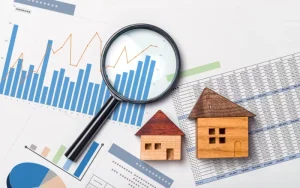When investing in commercial property, it is important to carefully evaluate the risks associated with different types of properties. Commercial real estate encompasses many properties, including office buildings, retail spaces, industrial warehouses, hospitality properties, and mixed-use developments. Each type of property comes with its own set of unique risks and considerations that should be thoroughly analyzed before making any investment decisions.
In this article, we’ll explore the various factors that contribute to the risk levels of different commercial properties. By understanding these risks and considering them in your investment strategy, you can make informed decisions that align with your financial targets and risk tolerance.
Office Buildings: Risk Factors and Considerations
Office buildings can be a risky investment due to various factors and considerations, especially in the realm of commercial property. One of the major risk factors is office building occupancy. The success of an office building investment relies heavily on its capacity to attract and retain tenants. If a building has a high vacancy rate, it can be difficult to generate consistent rental income, making it a risky proposition for investors.
Environmental hazards are another important consideration when assessing the risk of investing in office buildings. These hazards can range from contamination due to hazardous materials used by previous occupants to potential health risks linked with poor indoor air quality. Conducting thorough inspections and evaluations before purchasing an office building is crucial in identifying any existing or potential environmental hazards that could pose financial or legal liabilities.
Moving on to assessing the risks of commercial property, specifically retail spaces, it is essential to analyze certain factors affecting their profitability and sustainability without overlooking possible challenges.
Assessing the Risks of Retail Spaces in Commercial Property
When evaluating the risk involved in retail spaces, it is crucial to consider a multitude of factors. One of the key aspects to assess is the profitability of the retail space. Before investing in a retail property, it is important to thoroughly evaluate its potential for generating income. Factors such as location, foot traffic, competition, and market trends play a vital role in determining the profitability of a retail space or any other commercial property.
To better understand the risks associated with retail spaces, it can be helpful to examine them through a risk assessment table:
| Risk Factor | Description |
| Economic Conditions | Evaluating how economic downturns may impact consumer spending and affect the profitability of retail businesses. |
| Lease Terms | Analyzing lease agreements and understanding any potential risks or limitations imposed on tenants by landlords. |
| Tenant Mix | Assessing the variety and quality of tenants within a retail center to determine if they complement each other or potentially create conflicts. |
| Property Condition | Considering the physical condition of the property and any maintenance or renovation costs that may arise. |
| Market Competition | Studying competing businesses in proximity to assess their impact on customer demand and sales potential for retailers within the space. |
By carefully evaluating these factors and conducting thorough research, investors can understand the risks associated with commercial property, including retail spaces, before making any investment decisions. Understanding these risks will allow them to make informed choices regarding their investments in commercial property.
Understanding the Volatility of Industrial Warehouses
Industrial warehouses are indeed subject to volatility due to various risk factors. Here are some factors that contribute to the market volatility of commercial property, particularly industrial warehouses:
- Regional and Global Economic Factors: Industrial warehouses are influenced by macroeconomic conditions, such as GDP growth, interest rates, inflation, and consumer spending. Economic fluctuations can impact the demand for warehouse space as businesses adjust their production and inventory levels.
- Supply and Demand Dynamics: The availability of industrial warehouse space and the demand from businesses play a significant role in determining market volatility. Oversupply of warehouses in a particular area can lead to high vacancy rates and downward pressure on rental rates.
- Infrastructure and Logistics: The location and accessibility of industrial warehouses are crucial for businesses. Changes in transportation infrastructure or shifts in supply chain management practices can impact the demand for warehouse space in specific areas, causing volatility in the market.
- Government Regulations: Government policies and regulations related to trade, tariffs, zoning, and environmental compliance can affect the operations and demand for industrial warehouses. Changes in regulations can introduce uncertainty and impact the market dynamics.
- Technological Advancements: Technological advancements, such as e-commerce, automation, and artificial intelligence, can significantly impact the demand for industrial warehouses. The rise of online retail and the need for efficient last-mile delivery systems have driven the demand for strategically located warehouses near urban centers.
Overall, industrial warehouses in the commercial property sector carry a certain level of volatility due to their dependence on specific industries and vulnerability to economic fluctuations. Understanding these risks is crucial when evaluating investment opportunities in the commercial real estate industry.
Hospitality Properties: Evaluating the Risks

If you’re considering investing in hospitality properties, it’s important to evaluate the potential risks involved carefully. Hospitality properties, such as hotels and resorts, can be lucrative investments but come with their fair share of challenges. Here are some key factors to consider when evaluating commercial property in the hospitality sector and mitigating risks in this area.
- Market Conditions: One of the crucial aspects of evaluating a hospitality property is understanding the market conditions. Analyze factors like tourism trends, local demand, competition, and economic stability to gauge the potential success of your investment.
- Operational Costs: Running a hospitality property requires continuous maintenance and operating expenses. Consider factors such as staffing costs, utilities, property management fees, marketing expenses, and other overheads that may impact your profitability.
- Seasonality: Many hospitality properties experience seasonal fluctuations in business due to vacation patterns or events. Evaluate how these fluctuations affect your occupancy rates and revenue streams throughout the year.
- Reputation Management: In today’s digital age, where customer reviews hold significant influence, maintaining a positive reputation is essential for any hospitality business. Assessing online feedback platforms and implementing strategies for maintaining guest satisfaction is crucial to mitigate reputational risks.
Understanding these factors will help you make knowledgeable decisions when evaluating hospitality properties and mitigating associated risks. Now let’s explore another aspect of commercial real estate – mixed-use developments: balancing risks and rewards.
Mixed-Use Developments: Balancing Risks and Rewards
To effectively balance the risks and rewards of mixed-use developments, you must carefully assess market demand, zoning regulations, community engagement, and urban planning considerations. Here’s what you need to know for each aspect:
- Market Demand: Developers should conduct thorough market research to understand the demand for residential and commercial spaces in the planned development area. This research helps determine the appropriate mix of units for the project. It ensures that the development aligns with potential residents’ and businesses’ needs and preferences.
- Zoning Regulations: Zoning regulations govern the types of activities allowed in specific areas. Developers must understand and comply with these regulations to avoid legal issues. By adhering to zoning regulations, developers can ensure that the mixed-use development is appropriately planned and meets the requirements of the local authorities.
- Community Engagement: Involving local stakeholders and the community in the decision-making process is crucial for the success of a mixed-use development. Engaging with community members helps create a sense of ownership and allows developers to consider the community’s needs and concerns. This engagement can lead to greater project support and help address potential conflicts or opposition.
- Urban Planning Considerations: The layout and design of the mixed-use development should consider various urban planning factors. These include traffic flow, parking availability, and access to public transportation. By carefully evaluating these considerations, developers can mitigate potential challenges such as congestion, lack of parking space, or limited accessibility.
Overall, balancing the risks and rewards of mixed-use developments, including commercial property, requires a comprehensive understanding of market demand, compliance with zoning regulations, community engagement, and careful urban planning considerations. By addressing these factors effectively, developers can increase the likelihood of a successful and sustainable mixed-use development.
The Bottom Line
When it comes to commercial property, each sector carries its own set of risks and considerations. Office buildings can be subject to economic downturns, tenant turnover, and technological changes. Retail spaces face the challenges of changing consumer preferences and the rise of online shopping. Industrial warehouses are affected by fluctuations in supply and demand, as well as changes in trade policies.
Hospitality properties are vulnerable to tourism trends, competition from home-sharing platforms, and global events that impact travel. Mixed-use developments offer a combination of risks and rewards, with the potential for high returns and increased complexities in management.
If you’re looking for a commercial property investment that corresponds with your goals and risk tolerance, contact us at 3D Real Estate today. Our professional team is here to guide you toward successful opportunities.




